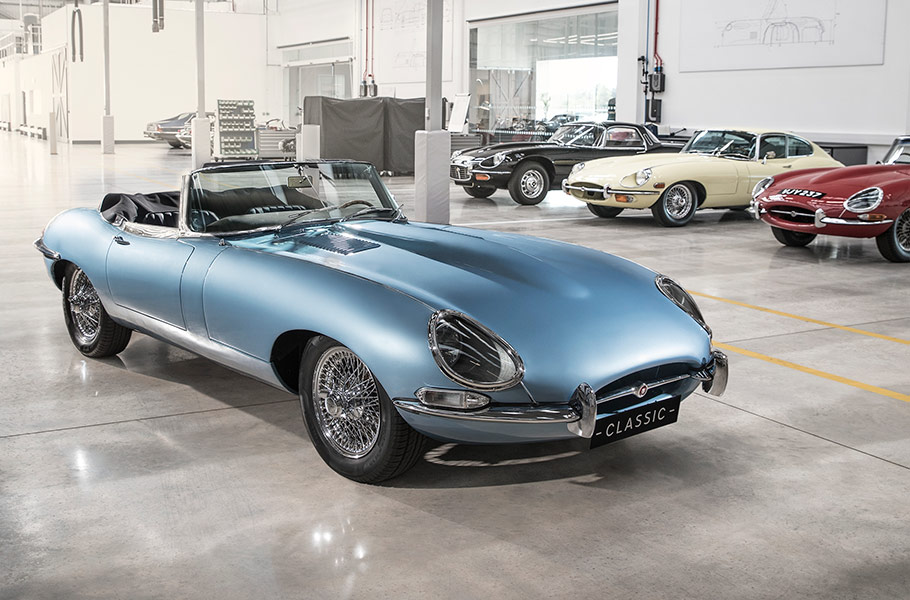Reinventing the Luxury Classic Car for the Electric Era By Clive Hartley
Recently, we worked with an engineering company in the Midlands who use additive manufacturing - 3D printing to you and me - extensively. One of the key applications for this, they explained, was to re-manufacture parts for classic cars when the originals are no longer available. They digitally scan and rebuild original components and then 3D print new parts in metal, using techniques pioneered in the aeronautical industry. This results in components with better tolerances than the originals and also means that these can be tailored to the vehicle, a crucial factor with classics as any given car can be subtly different (and sometimes not so subtly different) to another example of the same model, depending on factors such as what part of the production run it is from.
Do these measurably better, modern parts make a classic car better? Or does act of restoring somehow rob a vehicle of its originality - of its authenticity - in some way? There is a thought experiment called the ship of Theseus that asks how we should consider the boat of the great Greek hero if it had been placed in a museum after his adventures but over the course of the years each plank of wood had been replaced one by one as they had rotted. Would it still be the same boat once every piece had been replaced? And if not, is there a tipping point when it ceases to be the same boat? What does this mean for classic cars? Does their soul reside in their VIN plates or in every detail?
For a long time, the clear winners at Concours D’Elegance were typically cars that had been the subject of (or subjected to, depending on your point of view), extensive restorations. These cars had often been elevated to a quality level that their original manufacturers could only dream of. Recently however, the preference has been towards unrestored authenticity, which suggests treating a car almost as work of art or a holy relic - its value lying in its craftsmanship or in the physical link it provides to a famous, long-dead driver or a legendary race long since run.
It follows then, that the value of any such car with a significant backstory is intrinsically linked to its originality and authenticity. The more a vehicle is changed from how it first left the factory, the more that link is broken and hence, the more it loses its value.
The result of this is that many classics are practically too precious to actually be used by all but those owners with the very deepest pockets. So what are the options if you simply don’t dare drive your four-wheeled slice of history?
Jaguar and Aston Martin have created ‘continuation’ versions of classic models such as the XKSS, Lightweight E-type and DB4 GT. Which are represent the next best thing, surely? These cars aren’t original per se, but they are being made to the original drawings wherever possible, using original techniques and by the original manufacturer.
And if a manufacturer can’t be persuaded to perform their greatest hits again, other, smaller companies often step into fray. Bob Petersen engineering in the UK will build you a new Blower Bentley (if you can find them an old chassis). And they won’t stop there, the Devon-based company has produced their own unique bodies for vintage Bentleys, inspired by the work of contemporary coach builders. Aston Martin has even recently announced ‘continuation’ models of a car that never really existed - the DB5 featured in the James Bond film Goldfinger. Yes, it does have a revolving number plate… So as you can see, the boundaries of what is actually authentic are starting to get a bit blurry.
It also follows that if you are going to build a new car anyway, why not make it as good as a modern car? Why not benefit from modern chassis, engine and suspension design, not to mention state-of-the-art electronic control?
This then, is crossing the line from restoration to modification - welcome to the world of resto-mods. It’s where companies such as Singer come in. Boldly re-working Porsche 911s and finding a soulfulness and spirit that even Weissach seems to have forgotten how to conjure up. Also in California, Icon 4x4 have built fantastic resto-mod Toyota FJs and Ford Broncos, adding pin-sharp 21st Century detailing to designs that are pretty much the classic blue jeans of car culture. In the UK, Eagle have produced some refined new versions of the Jaguar E-type, staying true to Malcolm Sayer’s classic lines whilst updating performance to modern levels.
This more open-minded approach to contemporary classics has finally caught on with OEM’s, Porsche, presumably tired of seeing Singer rocking on their Pfennig, has decided if you can’t beat them, join them, and is launching Project Gold at Pebble beach this year, which, disappointingly, is not a 911 inspired by the greatest hits of ABBA but a one-off 993 resto-mod created by Porsche Classic. Jaguar has even made an electric Jaguar E-Type, the Concept Zero, proudly made by the JLR Classics division, motto: ‘We future history’, a succinct slogan boldly defiant of the need for verbs in English.
This shift in values has been evident in classic car events - in recent years the Pebble beach Concours D’Elegance has increasingly showcased vehicles both old and brand new - the latter often leaning heavily on the heritage and history of a marque. Although in case of Infiniti, a brand that is only 29 years old, they used the show as an occasion to display a retro-styled concept - Prototype 9 - that was based on an imagined 1940s Grand Prix racer from their past. It is a thought-provoking act when typically premium brands derive much of their value from their history and the wisdom and experience it is seen to have endowed them with. Infiniti seem to be suggesting that if you like what you see, it doesn’t matter when it was created or how it came to be there.
It’s an interesting change of approach for car companies. Whilst they have always leaned heavily on past glories, it is only in last 20 years or so that many have begun to re-imagine their classic designs. Arguably, this was started by, designer J Mays in his time at VW and Ford. The Concept One ‘New Beetle’ and Fords Thunderbird, Mustang and GT were described at the time as ‘retrofuturism’ due to the way they mixed clean, modern surfacing with lines that drew their inspiration quite clearly from cars of an older, more romantic (or is that more romanticised?) era.
An intelligent mix of comfortable, familiar shapes with modern, forward-looking surface treatments obviously meets the needs of many people for products that, whilst recognisable, are not retro. It is an approach that is reflected in other industries too - TAG Heuer and Omega have reissued many watch designs from their back catalogue with proportions and movements tweaked to meet the expectations of a market that, whilst far more advanced than that of 40 years ago, still seemingly doesn’t trust itself to create its own icons. And let’s not get started on the film industry. Perhaps this is symptomatic of the cautiousness of many big companies these days. Why risk time and money on an untried new product when you can make a sequel to a past success? That’s why the Star Wars franchise cost Disney $4 billion. A pessimist might ask if we have so little faith in our own skills and judgement that we don’t trust ourselves to come up with anything better than the designs of our parents? Or is re-examining our collective past, re-packaging and re-presenting it an important act of therapy? A necessary path to more clearly understanding who we are today by looking at who we used to be and who we wanted to be?
Let’s face it, sometimes it’s important not to give up on childhood dreams.












